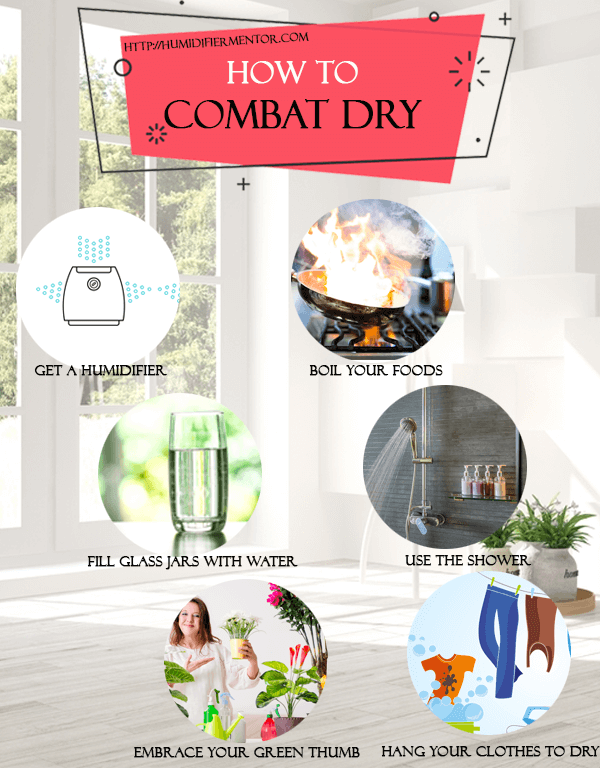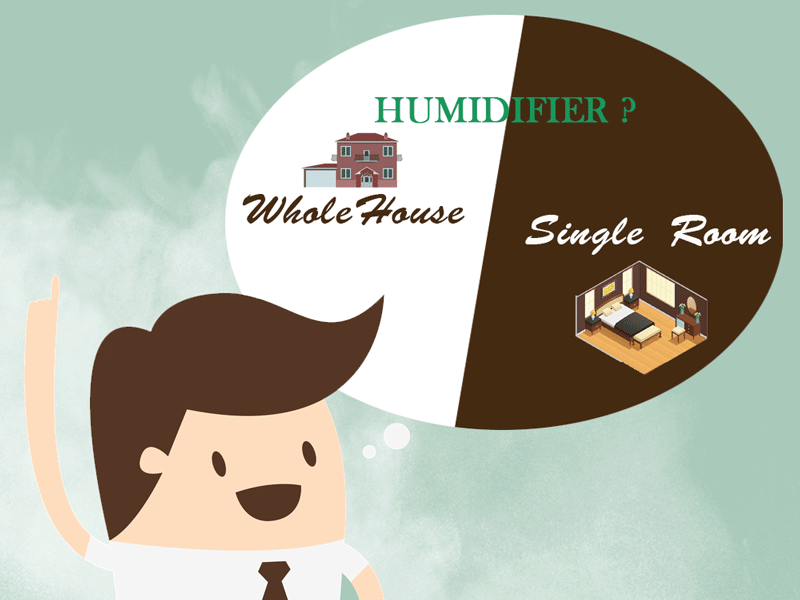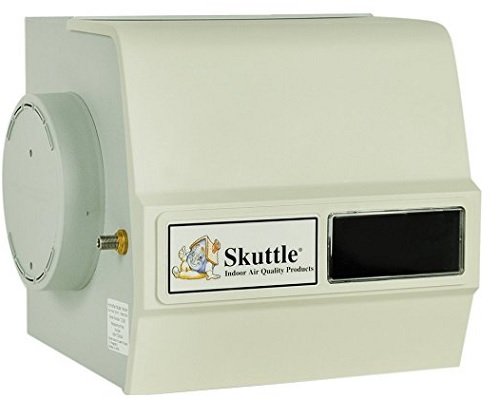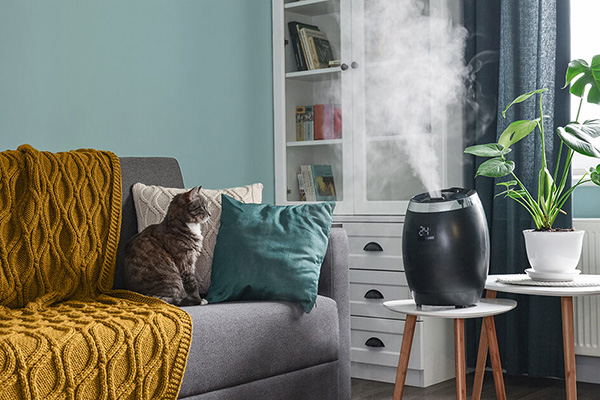The exact cause of dry air in your home will depend on many factors. In some cases, the climate where you live is so dry, it is natural for the air in your home to lack moisture. However, the most common culprit behind dry air in your home will be the use of a heating system.
We can all understand this pretty easily; when things get hot, they tend to dry out. We see this with our clothes in the dryer, food left to cook too long, and our hair when using a blow dryer. However, you might not understand the science behind it.
When air gets hot, the molecules expand; when it gets cool, they contract. This alters the ability of the molecules to hold water. Relative humidity is the measurement of water vapor in the air. When air is hot, it can actually hold more water, leading to greater relative humidity, which might make you wonder why your air is so dry when you are heating it.
Essentially, this happens because the heated air in your home is pulled in from the outside by your furnace. Outside, the air is much colder, which means the molecules are contracted and hold less moisture. As they heat up inside the home and expand, they are unable to increase the amount of moisture they hold because the air inside is dry and there is little additional moisture to pull from. The longer you run the heat in your home, the more cycles of this you go through, leading to noticeably dry air in your home. Because of this, you must add humidity to the air.
What Problems Can Result from Dry Air?
Now you might be wondering if dry air is really that big of a problem. In short, yes, it is. Dry air can wreak havoc on your health and your home. Below are some of the more concerning problems that can result from dry air.
Dry air makes it harder for your body’s defenses to fight off germs and bacteria. This is because your mucus membranes in your nose and throat are the body’s first line of defense against illnesses. These membranes capture everything from dust to viruses, preventing them from reaching the respiratory system. When dry, their ability to capture items is diminished, making it more likely that viruses and bacteria will make their way to the lungs, facilitating their ability to then move throughout the body.
Dry air is particularly irritating to the sinuses and nasal passages. Because we mostly breathe through our noses, they are the first point of contact our body has with dry air besides our skin. This dries out the tissues and membranes, causing itching, nose bleeds, and irritation.
As noted, the true first point of contact between our body and dry air is our skin. Why staying hydrated in general helps to hydrate the skin, our skin also pulls a lot of moisture from the air. When the air is dry, the skin will itch, flake, and become tight. If the problem is left untreated, the skin can chap and crack. And should you have other skin conditions, such as eczema, they will flare up.
Static shock is also a symptom of dry air. In fact, it may be the first sign you notice to indicate that the humidity levels in your home are dangerously low. If you notice that your clothes are staticy, that your hair is trying to stand on end, or you are accidentally shocking others too much, you have a problem with low humidity and need to take steps to remedy it.
Dry air tries to hydrate itself by pulling moisture from whatever source possible. This means that it will pull it out of your walls, floors, and even base structure of your home. This can lead to structural problems and force you to replace items like hardwood floors decades earlier than you would expect. It will also pull moisture from furnishings, which is particularly problematic if you have any antique or heirloom pieces.
If you do not treat dry air, you will end up with a higher energy bill. This is one of those things that seems counterintuitive. A humidifier needs power, so using one would increase your energy bill, right? Well, because dry air pulls moisture from wood, it tends to decrease the effectiveness of door and window seals, causing you to heat your home more and more. Also, when your skin is dry, you feel colder, which also makes you turn the heat up. As such, you will waste more in energy costs by not having a humidifier than by having one.
Can Too Much Moisture Become a Problem?
Just like too little humidity is problematic, too much is also no good. The ideal range for relative humidity levels in the home is between 35 and 60 percent. Any higher than 60 percent and there will be negative effects to your health and your home. Some of these effects include:
- The body overheating, exacerbating other health problems, such as asthma.
- Bacteria and viruses multiply in humid environments, turning your home into a petri dish.
- Humid air keeps these bacteria and viruses airborne for longer, making it more likely you will breathe them in.
- Also more likely to thrive in humid environments are dust mites and fungi.
- Humid air even holds onto chemicals better than dry air, which means you breathe in more pollutants.
- Mold also grows in moist environments, which can lead to deadly health consequences.
As such, if you decide to add a humidifier to your home, it is important you are careful with how you use it. To monitor your humidity levels, it is a good idea to purchase a humidifier with a humidistat or buy one separately.
Signs of Dry Air

Now that you know the problems that can be caused by dry air, you need to know how to tell if dry air is a problem in your home. Below are the most common signs that indicate you could have dry air in your home.
- Static electricity
- Runny nose
- Feeling fluish
- Nose bleeds
- Increase in allergy and asthma flare-ups
- Congestion
- Dry throat and dry mouth
It is important to note that these signs can also indicate too much humidity, save for the static electricity. As such, you should check the humidity levels in your home before you purchase a humidifier; you might discover that what you need is a dehumidifier instead.
How to Combat Dry Air
As we all now know, dry air is a major problem. And this means you need to find ways to fight it. To help you make your air healthier and more comfortable, try some of the ideas below.

Get a Humidifier
You probably expected this to be here, given this is a humidifier buying guide, but it isn’t just here because we have to include it. In terms of combating dry air, there is no option that is as effective and long-lasting as a quality humidifier. This gives you maximum control over your air and ensures that you get instant relief.
Embrace Your Green Thumb
Houseplants keep the air moisturized through the transpiration process. This process allows the moisture within the leaves of plants to evaporate, increasing the humidity in the air. However, you will need to water them more than expected since the air is dry.
Fill Glass Jars with Water
And then place them in window sills so they get direct contact with sunlight. The sunlight will heat the water, causing evaporation. This in turn moisturizes the air. You can use any clear glass jar for this.
Boil Your Foods
Okay, so you won’t want to do this with everything, but when it makes sense, go for it. Water evaporates when it gets hot, and boiling water evaporates quickly. See if you can find ways to incorporate boiling into your cooking routine a bit more.
Use the Shower
Do you love to take steaming-hot showers? Then skip the fan and leave the door open. This will allow the moisture to move throughout the home, combating dry air. It is a great way to make a difference without needing to spend money.
Hang Your Clothes to Dry
Due to colder temperatures, your clothes may not dry in full, but that is okay. Allow them to hang for at least two hours so some of their moisture enters the air. After that, toss them in the dryer and let it finish the job.
Type of Humidifiers
While you can and should try all the tips and tricks mentioned above, the most important one is to get a humidifier. But deciding you are going to buy one is just the start; now you need to figure out which type is right for you. To make this easier to understand, we will divide the different types into two main categories: whole-house humidifiers and single-room humidifiers.
Whole-House Humidifiers
· Drum Humidifiers: This type of humidifier goes on the cold-air return line; a motor pulls water into the drum and then pushes it through the system, creating a mist through evaporation that is then forced into the HVAC system. These are easy to install but require lots of maintenance since you must clean the drum often to prevent mold growth.
· Flow-Through Humidifiers: This type of humidifier can go on the return or supply line and also create a mist through evaporation that is pushed into the HVAC system. However, there is no drum, which means there is no standing water. The upside to this is it requires less maintenance, but the downside is that it requires a direct connection to a water line.
· Mist/Steam Humidifiers: Compared to the options above, this one is more costly but lower maintenance. It is also highly effective. Rather than using evaporation to create the mist, it uses steam. This makes it easy to control the humidity level. You can purchase both cold and hot water models.
· Ultrasonic Humidifiers: This is the least common type of whole-house humidifier, but it becomes more popular with each passing year. With this type, water moves over a traducer that vibrates the water molecules, exciting them. As they become excited, they break up into smaller molecules, which are then forced into the HVAC system. They are very effective, but produce a residue called “white dust” that makes them high maintenance.
Single-Room Humidifiers
· Warm Mist Humidifiers: These humidifiers heat water until it is boiling and then release the steam this produces. These generally require filters because boiling water releases mineral deposits. Additionally, they are not recommended for homes with pets or children.
· Evaporative Humidifiers: These humidifiers blow air over a wet wick. This causes the water to evaporate. The machine then forces this moisture out into the air.
· Ultrasonic Humidifiers: The single-room version of this humidifier works just like the whole-house version. Water passes over a vibrating traducer, agitating the molecules, breaking them up, and then dispersing them into the air.
· Impeller Humidifiers: These humidifiers use a rotating disk to create a water mist. This is then expelled into the air.
Which Is Better: Whole House or Single Room?

In most cases, a whole-house humidifier will be the better choice. These humidifiers are more effective, require less maintenance, and take care of the entire home. They also make it easy to control the humidity level in the home. However, there are some cases where a single-room humidifier is the better option.
If you are renting, you may not have permission to install a whole-house humidifier. There is also the possibility that your water supply lines are not close enough to your air supply lines, leaving you with fewer options, which may not be right for you. Finally, whole-house humidifiers really only work with HVAC systems, and if you do not have forced air throughout the home, they are not an option. Ultimately, what is best for you depends on your home.
Features to Look For
Knowing the type of humidifier you want means you are closer to making your purchase. Now you need to learn about the various features you will need to look for when selecting the best humidifier for you. While there are many variables, we are going to go over those we feel are the most important to consider.
· Square Feet Covered: Whether you are wanting a whole-house humidifier or a single-room humidifier, you need to make sure it can handle the square feet of your space. If you have high ceilings, you will want to select a model that can handle more than your actual square footage since you will have more air to moisturize.
· Ease of Use: You do not want your humidifier to be a pain to operate. This means you need to strike a balance between having too many features and not having enough. Look for things like a humidistat, easy-to-rad display, and intuitive controls.
· Maintenance Level: Some types of humidifiers require constant maintenance, especially those for single rooms. This might be fine with you, or you might want a humidifier that requires less attention.
Top 10 Best Humidifiers for Dry Skin and Sinus Problems Reviews
Aprilaire 700 Automatic Humidifier

This whole-house humidifier is our choice for the best humidifier you can buy if you have a larger home and are looking for a whole-house model. Aprilaire 700 is a flow-through humidifier, which means that you do not need to clean it or fill the tanks. As such, you only need to complete maintenance on it once a year. As soon as you have this humidifier installed and turned on, it basically takes care of itself.
The digital console is easy to read and intuitive to use. It offers minimal controls to keep things simple while still giving you power over how it works. Due to the complexity of the unit, it is best that you allow a professional plumber to install it for you. While this adds to the cost, ultimately, the results are worth it.
AIRCARE MA1201 Whole-House Console-Style Evaporative Humidifier
Some homes have a lot of space that needs to be treated, but having a whole-house humidifier isn’t actually an option. For these homes, a console-style humidifier is a good choice. Console humidifiers are single-room humidifiers that are much larger than the usual model. As such, they can humidify more space and run for longer without needing to be refilled.
The AIRCARE MA1201 can take care of the air in spaces that are up to 3,600 square feet. Since it does not power through the HVAC system, it does count on having some way to move the air through the home, such as being pulled into the HVAC system, fans, or being used in open spaces. If your home has an open concept or tall ceilings, this is a good purchase for you.
BONECO Warm or Cool Mist Ultrasonic Humidifier
With whole-house humidifiers, looks are not a concern as the unit is hidden away. But for single-room humidifiers, it matters quite a lot. This is especially true if you decide to place them in living rooms and other spaces guests frequent.
So if you are wanting a quality single-room humidifier with a look that is not as awkward as some, this BONECO is a good option. The design is sleeker than most, allowing it to blend into your overall design. It has minimal controls, making it easy to use. However, the tank is relatively small, requiring daily cleaning and filling.
Honeywell HE360A Whole House Powered Humidifier

The Honeywell HE360A is another flow-through humidifier, which means that you perform maintenance on it just once a year, changing out the filters. However, it is also a more complicated install, so do not go DIY on this one. At 4,200 square feet, it works for most homes and even some retail spaces.
The biggest downside to this unit is that you will need to purchase the installation kit separately. This adds to the cost, and it also makes things a bit more complicated since you need to be certain you pick the right one. However, it delivers incredible results, ultimately making it worth it.
Cool Mist Digital Humidifier for Large Rooms

Are you wanting a single-room humidifier that isn’t just more attractive than the usual, but is also something of a statement piece? Then the Cool Mist Digital Humidifier for Large Rooms is the purchase for you. This humidifier has an unusual profile that makes it feel more like modern art than a household appliance.
This is a quiet model, making it a good choice for entertainment areas as well as bedrooms. It is easy to use, and even comes with a remote so you can turn it on and off without getting up. Finally, it also comes with a humidistat so you always know if you are within the safe humidity range.
Skuttle 190-SH1 Drum Humidifier

For those wanting a whole-house humidifier but cannot hook it up to a water supply line, a drum humidifier is the best option. The Skuttle 190-SH1 is a high-quality drum model that can humidify homes up to 2,500 square feet. It is very energy efficient and easy to install.
However, since it is a drum model, you must clean it and monitor it often. It also is not the easiest to control as you must set the level yourself, which means you need to know the humidity level as well. Since it does not come with a humidistat, you will need to purchase one separately.
Crane USA smartDROP Ultrasonic Cool Mist Humidifier White
The Crane USA smartDROP is a solid choice for a single-room humidifier. It works well, and it works hard, and it is not difficult to use. It also offers a different look, one that blends the traditional humidifier design with sleek curves to add interest.
Perhaps the most unique feature of this humidifier is that it is WIFI enabled, allowing you to control it when you are away from home. This is an ideal way to ensure that your air is comfortable when you return home without running the unit all day. It comes with an attractive stand and will shut off when empty.
Honeywell HE120A Whole House Humidifier
Unlike many other drum humidifiers, the Honeywell HE120A includes a humidistat, making it much easier to control the humidity level in your home. It also comes with the installation kit, cutting down on your out-of-pocket costs. Also, since it does not require a water supply, it is easy to install all on your own.
This unit is best for small to medium-sized homes. It requires frequent maintenance to insure the drum as water and that no mold is growing inside. However, this is easy to do and should not be a deterrent when it comes to considering this model.
Honeywell HCM350W Germ Free Cool Mist Humidifier
Most single-room humidifiers require you to turn them on and off and adjust the settings based on the humidity in the room, but not the Honeywell HCM330W. It comes with a humidistat and will automatically adjust itself based on the readings. Another feature that sets it apart from most single-room humidifiers is that it rotates 45 degrees, allowing more even dispersement.
The main attraction, however, is that it kills germs in the air, making your home healthier. It also has a color-changing night light that is sure to entertain. Ultimately, this is a great humidifier with a little extra fun included.
Crane Adorable Ultrasonic Cool Mist Humidifier
Finally, we cannot forget the little ones. And for a children’s room, you do not want just any boring humidifier. The Crane Adorable Ultrasonic Cool Mist Humidifier will keep your child’s room comfortable without creating scary noises or looking intimidating.
This humidifier comes in 17 different designs, making it easy to fit into the look of the room. It is designed with a heavy-duty base to prevent children from tipping it over. Finally, the cool mist ensures that it is not a risk to your child.
Final Words
When it comes to the best humidifier for dry skin and sinus problems, there is no one product that will work in all homes. The right choice for you will depend on your HVAC system, the location of your water lines, the size of your home, and what you have permission to do. However, we know that no matter your situation, one of our choices is the right one for you.




